A Guide to Gardening in Singapore
Discover how to master gardening in Singapore with our guide. Learn about tropical plants, balcony techniques, and tips for your urban oasis.
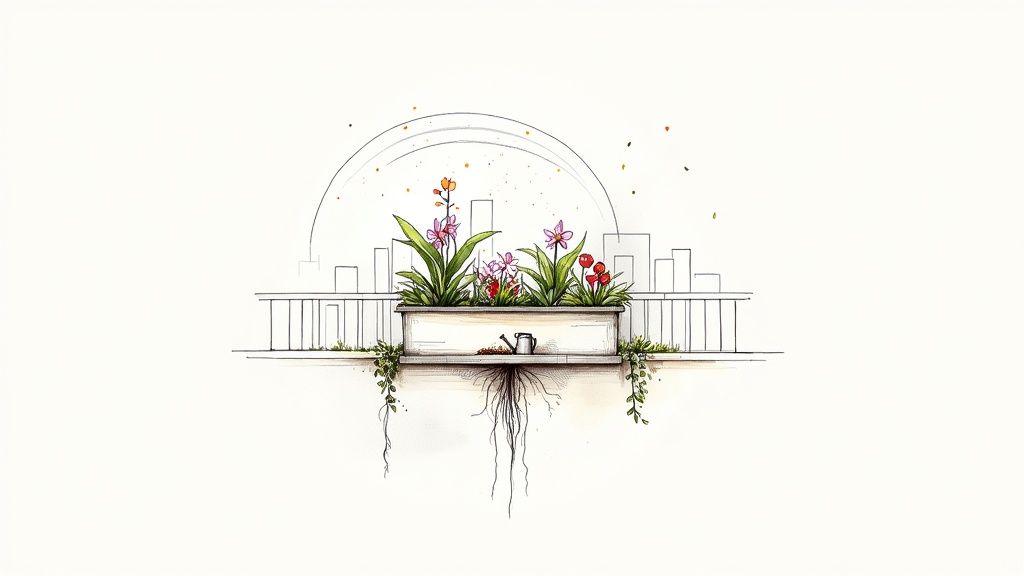
When you think about gardening in Singapore, it's really about getting creative with the spaces we have. It’s the art of turning HDB corridors and condo balconies into your own personal green sanctuaries. It all comes down to picking plants that can handle our tropical heat and humidity, and then mastering the art of container gardening to make every square inch count. This guide is here to walk you through exactly how to do that.
Why Start a Garden in Singapore
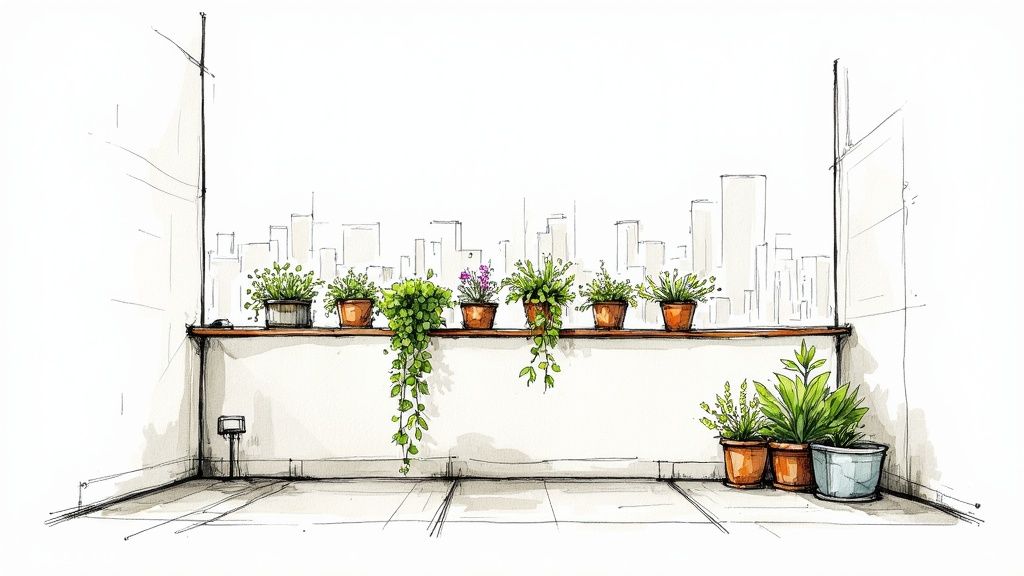
In a city as fast-paced as Singapore, the urge to get back to nature is something many of us feel. A small garden is so much more than just a pretty feature; it's a little retreat from the daily grind, a way to de-stress, and even a source of fresh herbs and veggies for your kitchen.
This guide is designed to help you tackle the unique challenges—and enjoy the incredible rewards—of gardening in our tropical, space-limited environment.
We’ll start from the ground up, covering the basics before moving on to more practical skills. Whether you’re working with a sun-drenched balcony or a shady corridor, you’ll find what you need to make your space thrive. If you're completely new to this, you might also find a detailed beginner's guide to starting a garden helpful for those first steps.
Embracing the Green City Vision
This growing passion for home gardening isn't happening in a vacuum. It’s part of a much bigger movement across Singapore towards sustainability and weaving nature right into the city’s design. This "biophilic city" philosophy is all about recognizing how vital green spaces are for our well-being and the environment.
You can see this trend everywhere, from massive architectural projects to the small plant pots lining a neighbour's walkway. The idea is to knit greenery into the very fabric of the city, making life better for everyone.
Think about the newer high-density developments—they almost always include significant green features. A perfect example is Marina One, with its incredible 65,000 square foot "Green Heart." It's a massive, living ecosystem designed to boost biodiversity and clean the air right in the middle of our central business district. This is all part of a larger strategy to cool the city and restore a bit of ecological balance, and your home garden is a small but important piece of that puzzle.
Here’s what you'll be equipped to do by the end of this guide:
- Understand Singapore's unique tropical climate and how to make it work for you.
- Choose tough, resilient plants that are a perfect match for our local conditions.
- Master container and vertical gardening to get the most out of your small space.
Working With Singapore's Tropical Climate
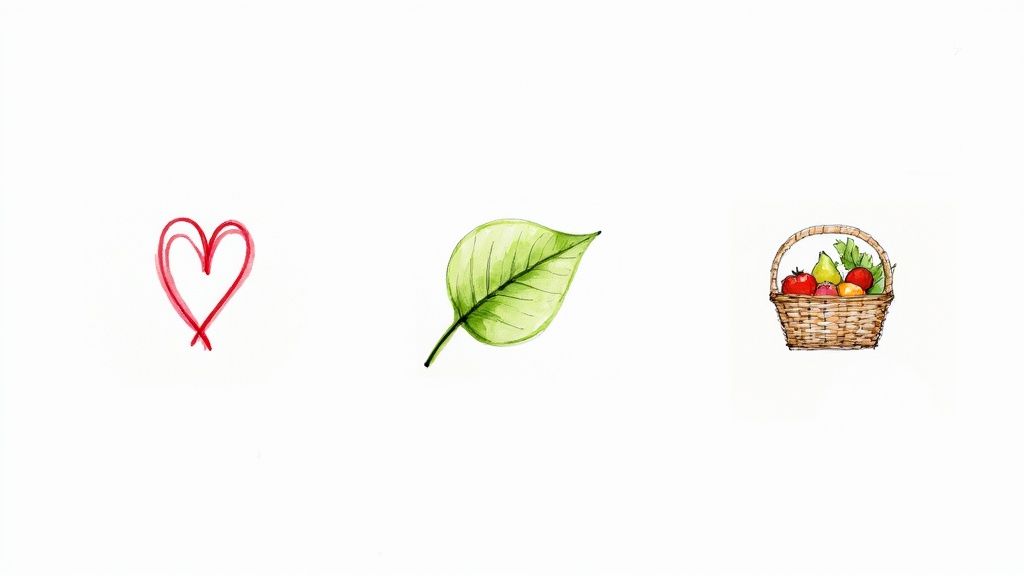
Gardening in Singapore isn't about fighting the climate; it's about learning its rhythm. Our equatorial spot gives us a sort of natural greenhouse. This can be a huge gift for supercharging plant growth, but it comes with its own set of challenges. To really succeed, you have to work with our year-round high heat, constant humidity, and distinct monsoon seasons, not against them.
Think of it this way: our climate takes the guesswork out of seasonal changes. We never have to worry about frost, and the growing season is essentially endless. This constant warmth means plants are always in go-mode, but it also creates the perfect playground for fungal diseases and pests if you're not careful.
The real secret is mastering three things: sunlight, air circulation, and water. Once you get a handle on managing these in your specific space, you can turn what seems like a challenging climate into your greatest gardening ally.
Making the Most of the Tropical Sun
The sun in Singapore is no joke—it's intense and direct. While this is exactly what sun-loving plants crave, it can easily scorch more delicate species. Your first job is to become a "sun mapper" for your own home. Spend a day or two just watching how the light moves across your balcony or corridor.
Does your spot get blasted by the harsh afternoon sun, or is it lucky enough to get the gentler morning light? This simple bit of knowledge is your most powerful tool for deciding where to put your plants. It’s the same principle used in large-scale urban greening projects. For example, the stunning biodiversity at Marina One in Singapore is a masterclass in arranging plants according to their light and shade needs.
You can easily manage the intense sun with a few simple tricks:
- Shade Cloth is Your Friend: A cheap and cheerful shade cloth can filter out the harshest midday rays, acting like sunscreen for your more sensitive plants.
- Play Matchmaker: Put your sun-worshippers like bougainvillea, chili, and curry leaf plants right in the brightest spots. Plants that prefer a bit of a break, like calatheas or snake plants, can be tucked behind them or in corners that get less direct sun.
- Huddle Up: Grouping pots together creates a more humid micro-environment. It also lets taller, tougher plants provide a bit of natural shade for their smaller neighbors.
Getting the Air Moving
Humidity is a classic double-edged sword for us here. It helps many tropical plants feel right at home, but it can also lead to stagnant, heavy air—which is basically an open invitation for fungal problems like powdery mildew. Good air circulation is the perfect fix.
Your garden needs to breathe. If your plants are all jammed together with no room for air to move, moisture gets trapped on the leaves, and that’s where the trouble starts. The goal is to make sure a gentle breeze can always find its way around each plant.
Good airflow does more than just stop disease. It helps plants with transpiration—the process of pulling water up from the roots and letting it evaporate from the leaves. This is how they cool themselves down and transport nutrients.
Here’s how you can boost the ventilation in your garden:
- Give Them Space: Try not to cram your pots together. Leaving a bit of room between containers lets air flow freely around the leaves of every plant.
- Prune Smart: Regularly trim away dense or excess foliage, especially from the middle of the plant. This opens up its structure and lets the air in.
- Lift Them Up: Using simple plant stands or pot feet to raise your containers off the ground works wonders. It helps with drainage and allows air to circulate underneath the pot, which is a huge help in preventing waterlogged soil and root rot.
By actively managing sunlight and airflow, you’re creating a space where your plants don’t just survive our tropical climate—they absolutely thrive in it.
How to Choose the Right Plants
The real secret to a lush, low-effort garden in Singapore isn't some complicated formula. It's actually quite simple: pick plants that are already built to succeed here. Instead of fighting to make a plant adapt, choose one that sees our tropical climate as its natural home. This mindset saves you a ton of work and sets you up for beautiful results right from the start.
Think of it like dressing for the weather. You wouldn't wear a thick jacket for a day at East Coast Park, right? In the same way, selecting plants that are native or well-adapted to the tropics is the single most important choice you'll make for your urban garden.
Matching Plants to Your Space
Before you even think about visiting a nursery, take a good look at your own space. Is your HDB corridor a shady little nook that barely sees the sun, or is your condo balcony a sun-trap that bakes in the afternoon heat? Getting a handle on your specific light conditions is everything.
A great way to begin is by sorting your potential plant picks into categories based on what they need and what you want to achieve. This turns an overwhelming task into a clear, strategic plan.
- Heat-Loving Edibles: These are the undisputed champions of Singaporean edible gardens. Plants like Kang Kong (Water Spinach), Chili Padi, and Sweet Potato Leaves absolutely explode with growth in our heat and can be harvested again and again.
- Vibrant Ornamentals: For a pop of colour, you'll want plants that thrive in humidity. Think of iconic choices like Orchids, hardy Bougainvillea that looks stunning cascading over a railing, or leafy wonders like Caladiums.
- Low-Light Champions: These are perfect for those indoor spots or corridors that don't get much sun. The nearly indestructible Snake Plant (Sansevieria) and the elegant ZZ Plant (Zamioculcas zamiifolia) are fantastic options because they're forgiving and tolerate lower light levels.
This visual guide breaks down the key environmental factors that will determine which plants truly thrive in your garden.
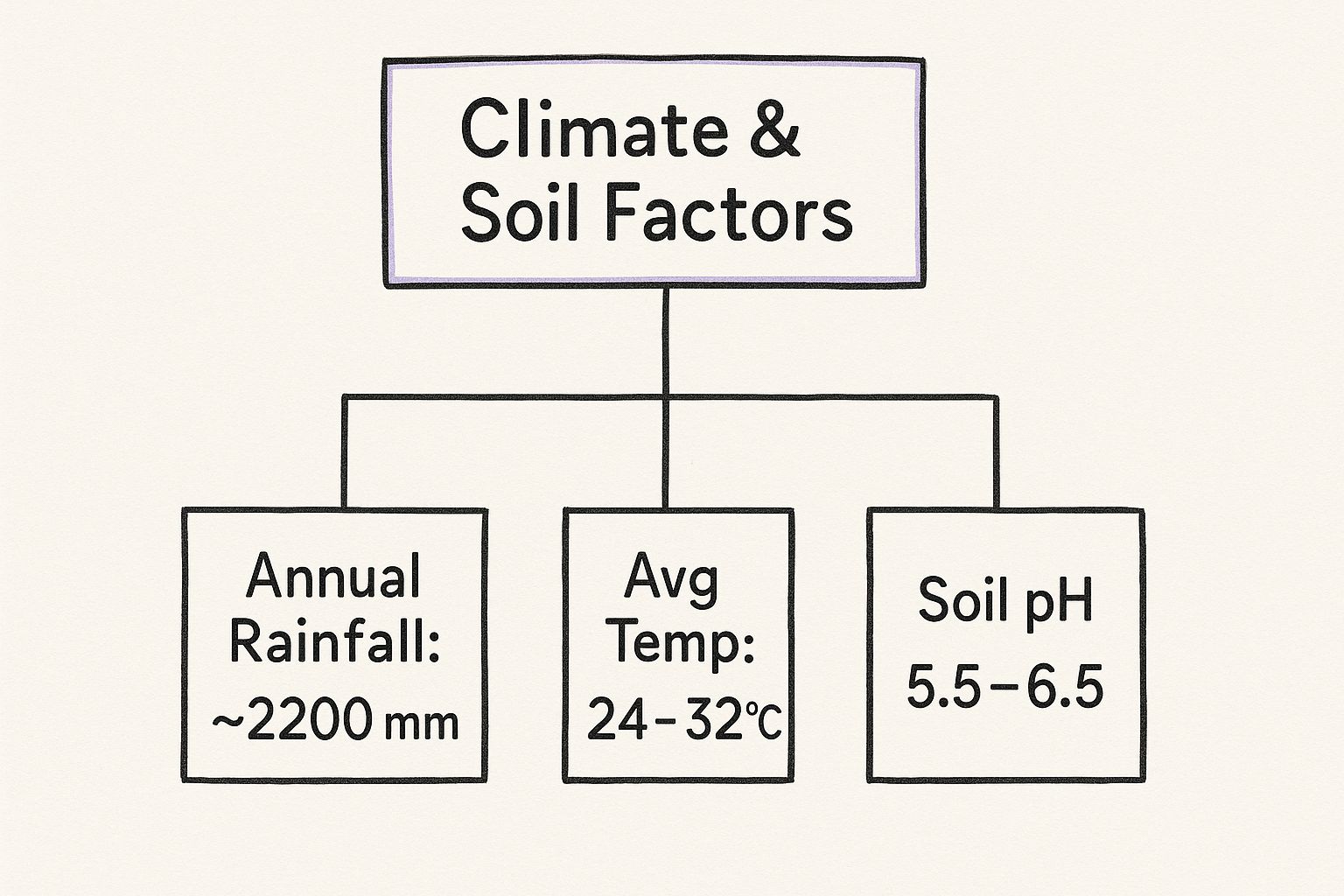
These numbers make it crystal clear why choosing tropical-adapted species isn’t just a good idea—it’s essential for successful gardening in Singapore.
Singapore Plant Selector Guide
To make things even easier, here’s a quick reference table to help you choose the right plants based on your home's sunlight and your gardening goals. Think of it as a cheat sheet for your next nursery trip.
| Sunlight Level | Best Edibles | Best Ornamentals | Key Considerations |
|---|---|---|---|
| Full Sun (6+ hrs) | Chilli Padi, Long Beans, Sweet Potato | Hibiscus, Bougainvillea, Canna Lily | Needs consistent watering to handle the intense heat. |
| Partial Shade (3-6 hrs) | Kang Kong, Mint, Basil | Orchids, Caladiums, Bird of Paradise | Ideal for morning sun spots; protects from harsh afternoon rays. |
| Low Light (<3 hrs) | Microgreens, certain leafy herbs | Snake Plant, ZZ Plant, Money Plant | Perfect for HDB corridors or north-facing windows; avoid overwatering. |
Using a simple guide like this helps you walk into a nursery with confidence, knowing exactly what to look for. It takes the guesswork out of the equation.
Decoding Plant Labels at the Nursery
A walk through a nursery can feel like information overload with rows upon rows of greenery. But those little plastic tags sticking out of the soil are your secret weapon. Learning to read them is like learning a new language—one that empowers you to make smart, confident decisions.
A typical plant label provides crucial clues. Look for terms like "full sun" (at least 6 hours of direct sunlight), "partial shade" (3-6 hours, preferably gentle morning sun), or "low light." This is your direct line to matching a plant with the light conditions you've already observed at home.
Choosing the right plant is all about finding that sweet spot where a plant's needs perfectly match what your home can offer. When these two align, your garden practically takes care of itself.
Putting in this effort up front pays off in the long run. The right plant means less time spent worrying about pests, diseases, and why it "just won't grow," and more time simply enjoying your green oasis. This growing passion for home cultivation is fueling a significant local market, too. In fact, the Lawn & Garden market in Singapore is projected to hit around US$1.28 billion in 2025.
Great Starter Plants for Singapore Gardens
If you're just starting out, it’s best to begin with plants known for being tough and forgiving. Easy wins build confidence and make the whole experience more fun. For more ideas on plants that love warm, humid weather, check out this guide on growing Canna lilies for stunning tropical gardens.
Here are a few foolproof categories to get you started:
For a Touch of the Tropics:
- Hibiscus: Loves full sun, produces gorgeous, big flowers, and is very forgiving if you get a little scissor-happy with pruning.
- Bird of Paradise: Prefers bright, indirect light and offers dramatic, architectural leaves that give an instant tropical vibe.
- Pandan: Happy in partial shade, it’s a breeze to grow and gives you fragrant leaves for cooking.
For Your Kitchen Garden:
- Basil: Thrives in the sun and is perfect for pots. The more you harvest, the bushier it gets.
- Mint: This one is incredibly easy to grow—almost too easy! It’s best to keep it in its own pot so it doesn’t take over your entire garden.
- Long Beans: A climbing veggie that adores the heat and will reward you with a huge harvest if given enough sun and something to climb on.
When you choose plants that are already at home in Singapore’s climate, they are naturally more resilient against local pests and diseases. It’s an approach that’s not just easier for you, but also more sustainable. As you get more comfortable, you can start exploring more unique plants. Keep in mind that different neighbourhoods in Singapore can have unique microclimates and community gardening scenes, which might open up even more possibilities.
Mastering Balcony and Container Gardening
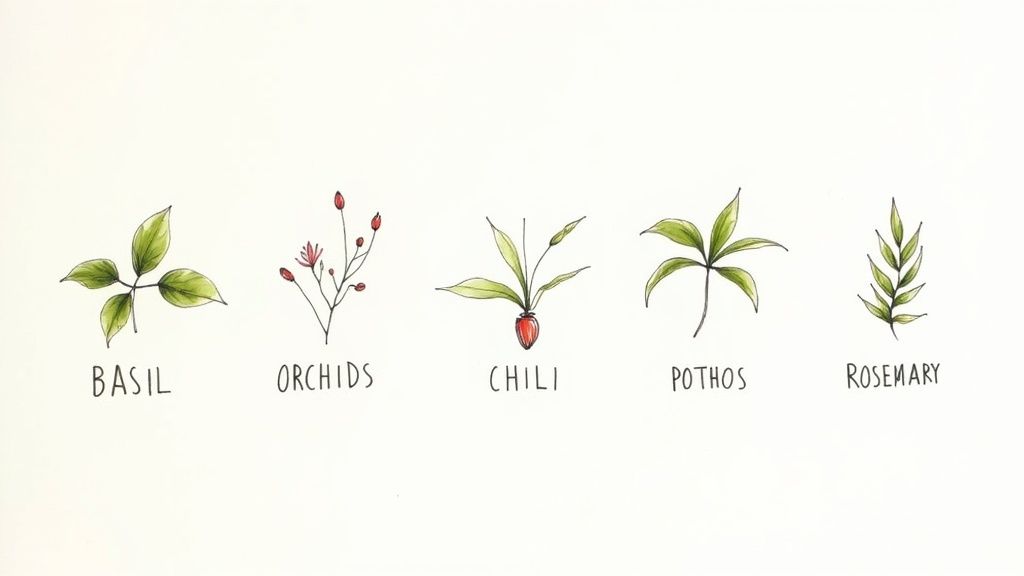
When you don’t have a sprawling backyard, you learn to think differently about space. For most of us gardening in Singapore, this means growing up—literally. Balcony and container gardening isn't just a niche hobby; it's the main way we connect with nature, turning compact HDB and condo spaces into our own green sanctuaries.
The real beauty of container gardening is its flexibility. You're in complete control of the growing environment, from the soil mix to the exact placement of each plant. This allows you to create the perfect conditions for your plants, even when you only have a few square feet to work with.
Choosing Your Containers Wisely
Your journey starts with the pot itself. The material you choose has a huge impact on your plant's health, especially in our hot and humid climate. This isn't just about aesthetics; it's about water management and keeping roots happy.
Think of terracotta pots as breathable clay containers. Their porous nature allows air and water to move through the sides, which helps prevent the soil from getting waterlogged—a common killer here. The downside? They dry out much faster, so you’ll need to water more often.
On the other hand, plastic pots are non-porous. They’re excellent at holding onto moisture, which can be a lifesaver for thirsty plants or for gardeners who might occasionally forget to water. They're also lightweight and come in endless styles, making them a super practical choice for urban gardeners.
Here’s a quick comparison to help you decide:
| Pot Material | Key Advantage | Key Disadvantage | Best For |
|---|---|---|---|
| Terracotta | Excellent drainage and aeration for roots. | Dries out quickly in the sun. | Plants prone to root rot, like succulents or herbs. |
| Plastic | Retains moisture well; lightweight. | Can overheat roots if dark-colored and in direct sun. | Thirsty plants like leafy greens and flowering annuals. |
| Glazed Ceramic | Stylish and retains moisture better than terracotta. | Can be heavy and expensive. | Feature plants where looks are a top priority. |
Creating the Perfect Soil Mix
Once you've picked your pot, the next step is filling it with the right foundation. You can't just scoop soil from the ground; it’s far too dense for containers. It will compact easily, strangling roots and holding way too much water.
Think of your potting mix as a "plant pantry," stocked with everything it needs. A good mix gives roots structure, holds onto moisture and nutrients, and lets excess water drain away freely. Nailing this balance is the secret to healthy container plants.
The perfect soil mix is a blend of structure, nutrition, and aeration. It needs to be a welcoming environment where roots can breathe, feed, and grow without becoming waterlogged or starved.
To build your own ideal mix, you’ll want to combine a few key ingredients:
- Potting Soil: This is your base. Look for a high-quality, peat-free mix that provides a stable foundation.
- Compost: This is the nutrition powerhouse. It adds essential organic matter and beneficial microbes that feed your plants over time.
- Perlite or Pumice: These lightweight volcanic rocks are crucial for aeration. They create tiny air pockets in the soil, preventing compaction and making sure roots get the oxygen they need.
A fantastic starting recipe is two parts potting soil, one part compost, and one part perlite. This creates a balanced, free-draining mix that’s perfect for most plants in our tropical climate. For more detailed strategies on growing edibles in tight spots, a dedicated guide on balcony vegetable gardening can offer specific tips to boost your harvest.
Going Vertical to Maximize Your Space
The real magic of balcony gardening is realizing your growing area isn't just the floor—it's the entire vertical plane. Growing upwards is the smartest way to increase your plant count and create a stunning wall of green.
Vertical gardening can be as simple or as complex as you like. You don't need a fancy, expensive system to get started. Many of the most effective solutions are simple, DIY-friendly, and perfect for the typical HDB or condo balcony.
- Railing Planters: These are the easiest way in. They hang directly over your balcony railing, instantly adding growing space without taking up any floor area. They're perfect for trailing flowers or easy-to-reach herbs.
- Stacked Systems: Tiered or stacked planters let you grow multiple plants in the same vertical footprint. These are ideal for growing a variety of herbs or leafy greens like lettuce and spinach.
- Wall-Mounted Trellises: A simple trellis is all that climbing plants like long beans or passionfruit need to thrive. This can turn a bare, boring wall into a productive and beautiful living feature.
Respecting HDB and Condo Regulations
As you design your green oasis, it's vital to be a good neighbour and play by the rules. HDB and condo management have guidelines in place for everyone's safety and comfort. Being mindful of these from the start saves you any trouble down the line.
Key Rules to Remember:
- No Obstructions: Make sure there's a clear passage of at least 1.2 meters along common corridors for fire safety.
- No Killer Litter: Never, ever place pots on balcony ledges or hang them insecurely where they could fall.
- Mind the Drip: Always use pot trays to catch excess water. Nobody wants their clean laundry ruined by your gardening runoff!
Living in close quarters requires a bit of consideration, and these practices are just part of being a responsible urban gardener. For more insights on creating a harmonious home, check out these helpful tips for apartment living. By combining smart techniques with community awareness, you can create a garden that is both beautiful and considerate.
Essential Watering Techniques and Tools
https://www.youtube.com/embed/XLOqTxshQyI
In Singapore's tropical heat, water is everything to your garden. But knowing when and how to water is less of a science and more of an art. Getting it right with the right tools and a smart strategy can be a complete game-changer, helping you sidestep the common pitfalls of over- and underwatering that can kill a plant fast.
Forget those overwhelming lists of gardening gear. To really succeed here, you just need a few high-quality essentials. Think simple, not complicated. A sturdy trowel for potting and a long-spout watering can are the absolute must-haves. That long spout is key—it lets you get water directly to the soil where the roots are, without splashing the leaves.
This focus on smart watering is a big deal in Singapore. The local gardening equipment market is growing, and water-related tools are the biggest piece of the pie, making up 39.07% of the market's revenue in 2024. This just goes to show how critical water-efficient practices have become for gardeners on the island. You can dig deeper into these market insights on water-efficient gardening practices for more details.
The Right Time and Technique
The rhythm of your watering schedule can make or break your garden. For our climate, early morning is the golden hour. The temperatures are cooler, so less water evaporates into the air. This gives it time to soak deep into the soil and hydrate the roots before the sun really starts beating down.
Watering in the evening can be a bit risky here. Because our nights stay warm and humid, wet leaves can become a perfect breeding ground for fungal diseases. Sticking to a morning routine gives the foliage plenty of time to dry out before nightfall, which keeps your plants much healthier in the long run.
Learning to Read Your Plant’s Thirst
So, how do you actually know when a plant is thirsty? Don't just stick to a rigid "every other day" schedule. The best way is to learn to read your plant’s cues with one simple, foolproof method.
The Finger Dip Test is the urban gardener's best friend. Just stick your index finger an inch or two into the soil. If it feels dry, it's time to water. If you feel any moisture, you can wait another day.
This simple check helps you avoid the number one killer of container plants: overwatering. It makes sure you're watering based on what your plant actually needs, not just what the calendar says.
When it is time to water, do it deeply. Give the soil a good, thorough soak until you see water running out of the drainage holes at the bottom of the pot. This encourages the roots to grow deep and strong, creating a much more resilient plant.
Sustainable Watering Solutions
For those of us with busy schedules or anyone keen on conserving water, modern tools offer some fantastic solutions that are perfect for the urban lifestyle. These systems are great for maintaining consistent moisture, even if you’re away for the weekend or just get a bit forgetful.
- Self-Watering Pots: These clever containers have a built-in water reservoir at the bottom. The plant wicks up moisture as it needs it, making them a brilliant set-and-forget solution for thirsty plants like herbs and leafy greens.
- Drip Irrigation Systems: These used to seem complicated, but today's kits are incredibly easy to set up. They deliver slow, steady drips of water right to the base of each plant, cutting down on waste and ensuring deep hydration. They're perfect for a line of planters on a balcony.
By picking the right tools and adopting these simple watering habits, you can create a lush, thriving garden that’s more than a match for the challenges of Singapore’s climate.
Solving Common Garden Headaches
Sooner or later, every gardener runs into trouble. It's just part of the journey. In Singapore, our wonderful warmth and humidity can, unfortunately, be an open invitation for pests and plant diseases. But don't see this as a failure—think of it as your plants trying to tell you something. Learning their language is the real secret to a happy, healthy garden.
The best strategy is always prevention. A strong, well-watered plant with good nutrition is its own best bodyguard, just like a person with a robust immune system. But when issues pop up, the key is to act fast with gentle, smart solutions. Dousing everything in harsh chemicals can do more harm than good, wiping out the helpful insects and throwing your garden's little ecosystem out of whack.
Who Are These Uninvited Guests?
In our tropical paradise, a few familiar troublemakers always seem to show up. Knowing who you're dealing with is half the battle. These critters are sneaky, often hiding under leaves or tucked into new growth, so make a habit of checking your plants over every few days.
- Mealybugs: You'll spot these as tiny, white, cotton-like fluff, usually bunched up where a leaf meets the stem. They're sap-suckers, and they'll cause leaves to yellow and growth to stall.
- Aphids: These are small, pear-shaped bugs that come in green, black, or yellow. They love to congregate on fresh, tender shoots and flower buds, leaving a tell-tale sticky mess called honeydew.
- Spider Mites: These are nearly microscopic, but you'll know they're there by the delicate, silky webs they spin on your plants. They also cause a stippled pattern of tiny yellow or brown spots on the leaves.
Spotted some? Your first move should be simple. A surprisingly strong blast of water from a spray bottle can knock a lot of them right off. If they're a bit more stubborn, a cotton bud dipped in a little rubbing alcohol will let you wipe them away individually.
A healthy garden is about balance, not a sterile, bug-free zone. The goal is to keep pest numbers in check, not to declare war on every insect. Choosing methods that support your plants' health and the local environment is always the better path.
Smarter, Greener Pest Control
For problems that just won't quit, an approach called Integrated Pest Management (IPM) is the way to go. It’s all about starting with the least toxic solution first to keep your garden’s natural harmony intact.
Go-To Organic Fixes:
- Neem Oil Spray: This stuff is a fantastic all-rounder, made from the extract of the neem tree. It messes with the life cycle of many common pests and even helps fight fungal issues. Just mix it according to the directions on the bottle and spray in the evening to avoid scorching the leaves in the sun.
- Insecticidal Soap: This isn't your regular dish soap. It's a special formula designed to break down the waxy outer layer of soft-bodied pests like aphids and mealybugs. It's tough on them but gentle on your plants.
When It’s Not a Bug Problem
Sometimes, a sad-looking plant has nothing to do with pests. The issue might be in its environment or your care routine. The good news is, these are often the easiest problems to solve once you know the signs.
- Yellowing Leaves (Chlorosis): This is the classic sign of a nutrient deficiency, most often a lack of nitrogen. But hold on—it can also mean you're overwatering and the roots are suffocating. Always check the soil first. If it's soggy, back off the watering can. If the soil feels fine, it’s probably time for a feed.
- Brown, Crispy Leaf Edges: This almost always points to underwatering or really low humidity. While low humidity isn't a huge issue in Singapore, the intense sun can dry out a pot in no time. Make sure you're giving your plants a good, deep drink on a regular basis.
- Root Rot: Is your plant wilting dramatically even though the soil is wet? You might have root rot. It's caused by too much water and not enough drainage. The only rescue mission is to repot the plant into fresh, dry, well-draining soil. While you're at it, be sure to trim off any roots that look black and mushy.
Getting good at diagnosing these common issues turns you from a plant owner into a true gardener. You'll develop an intuition for what your plants need, creating a little green sanctuary you can be proud of.
Got Questions? We’ve Got Answers
Embarking on a gardening adventure, especially in an HDB or condo, naturally comes with a few questions. Let's tackle some of the most common ones you might have, building on everything we've talked about to help your garden thrive.
What Are The Easiest Vegetables For HDB Corridors?
Think of your HDB corridor as a special microclimate. It’s often shadier than an open balcony, so you’ll want to pick plants that are happy without basking in the sun all day. Leafy greens are your best friends here.
Quick-growing favourites like Kang Kong (Water Spinach), Bayam (Spinach), and even Sweet Potato Leaves are brilliant choices. Not only do they tolerate lower light conditions, but you can also snip off what you need and they'll keep on giving. Herbs like mint and basil are also surprisingly happy with just a few hours of indirect sunlight.
To really maximize your limited footprint, use rectangular planters. They fit perfectly in narrow spaces and help you stay well within HDB guidelines.
How Often Should I Fertilize My Plants?
With our year-round growing season and the need for frequent watering, nutrients can get flushed out of your soil pretty quickly. Regular feeding is key to keeping your plants happy and productive. It’s like making sure the pantry is always stocked for them.
A great mantra for Singaporean gardeners is: "Feed weakly, weekly." It’s better to give your plants a diluted dose of fertilizer more often than a strong one occasionally. This provides a steady stream of nutrients without the risk of burning their roots.
For hungry plants like vegetables and flowers, a balanced liquid fertilizer every 2-4 weeks works wonders. For foliage plants that grow at a more relaxed pace, feeding them every 4-6 weeks is plenty. If you prefer a more set-it-and-forget-it method, mixing in some slow-release granular fertilizer every few months is a fantastic, low-effort alternative.
What Are The Main HDB Rules For Balcony Gardening?
Absolutely, the Housing & Development Board has a few guidelines in place to make sure everyone's gardening experience is safe and neighbourly. The rules are mostly common sense and boil down to being a considerate resident.
Here’s what to keep in mind:
- Safety First: Pots should never be placed directly on the balcony ledge or hung where they could become a falling hazard. Always secure them properly.
- Prevent Dripping: Make sure water runoff from your plants doesn't become a nuisance for your neighbours below. A simple pot tray under every pot is a must.
- Keep Corridors Clear: If you're gardening along the corridor, you must leave a clear passage of at least 1.2 meters for safety and accessibility.
Stick to these simple rules, and you can cultivate a stunning green space without any worries.
At UPPERHOUSE at Orchard Boulevard, we believe that green living and urban sophistication can coexist beautifully. Imagine cultivating your own private herb garden on your balcony, with the vibrant energy of Orchard Road just steps away. Discover a residence where every detail is designed for a life of refined comfort and connection to nature. Find your exclusive urban sanctuary at UPPERHOUSE today.
Related Articles
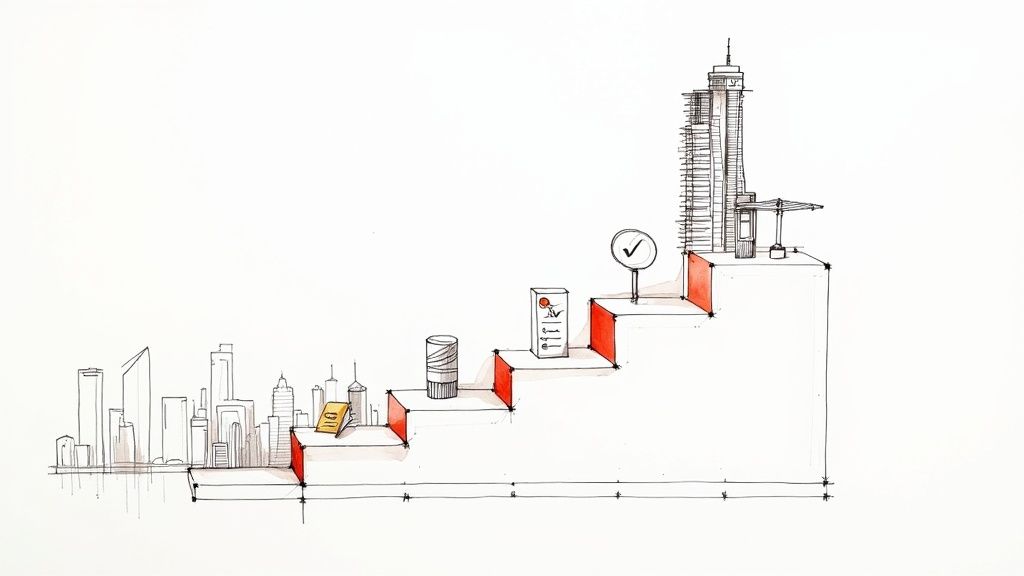
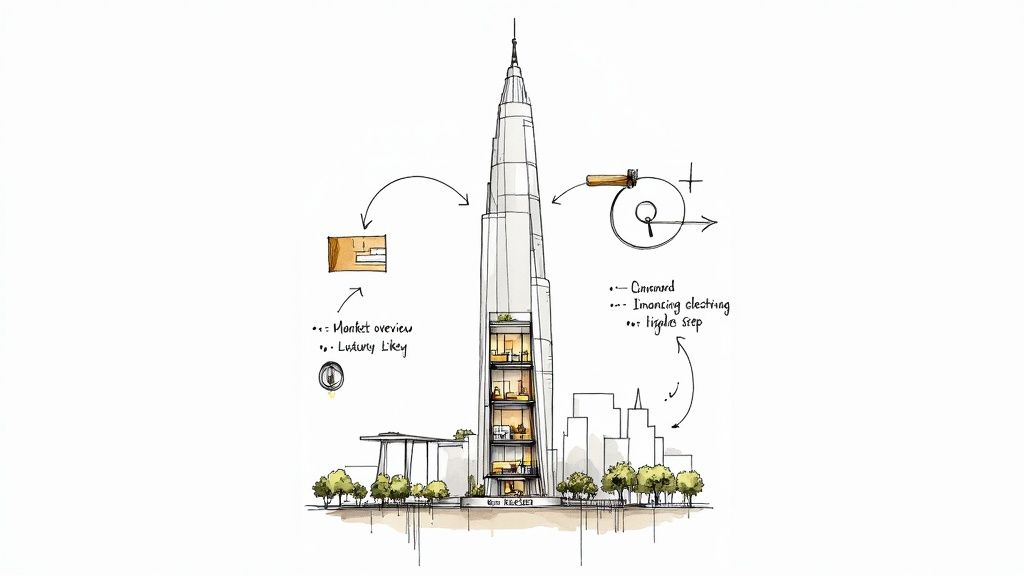

Interested in UPPERHOUSE?
Discover luxury living at UPPERHOUSE at Orchard Boulevard. Get exclusive updates and be the first to know about availability.